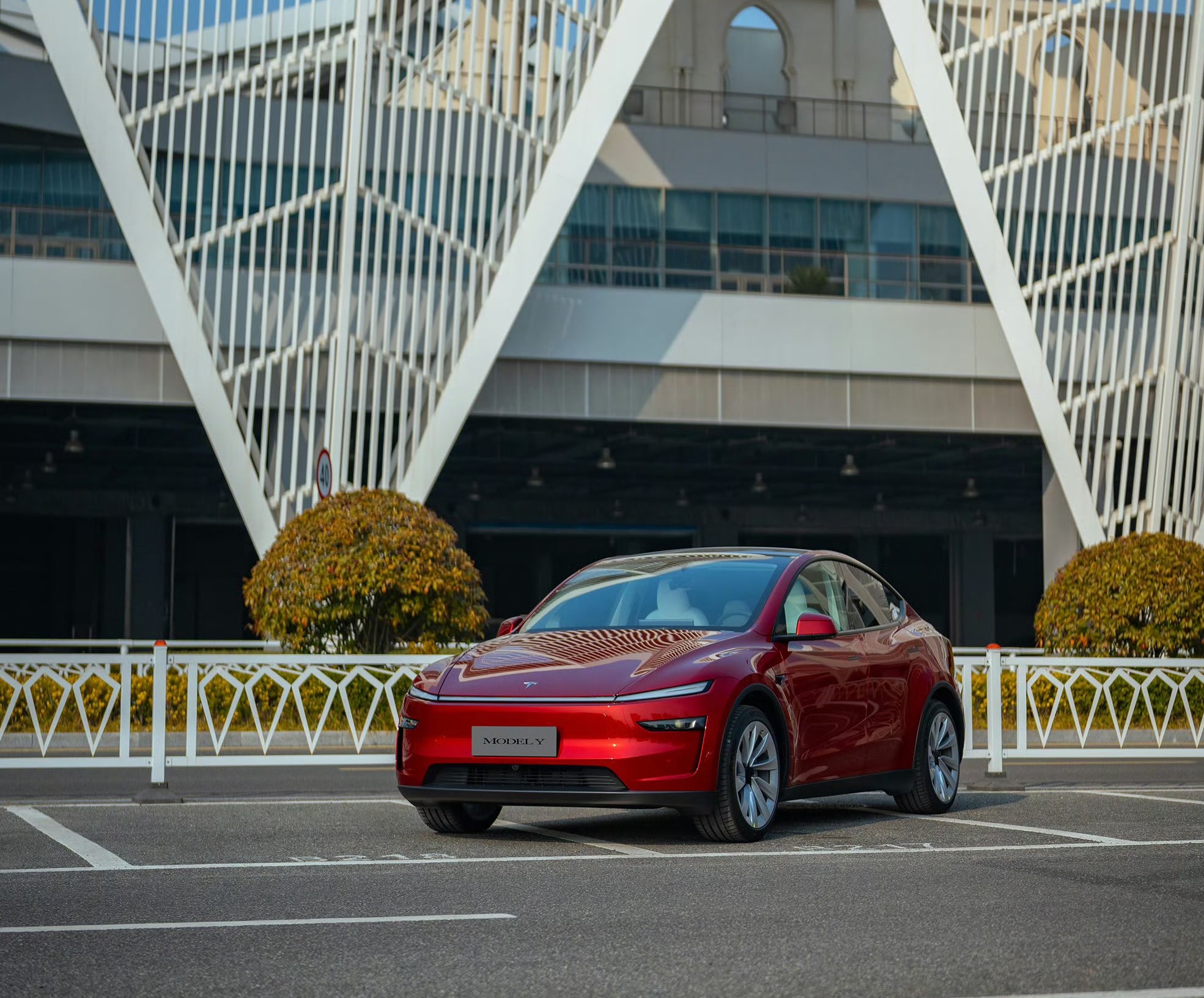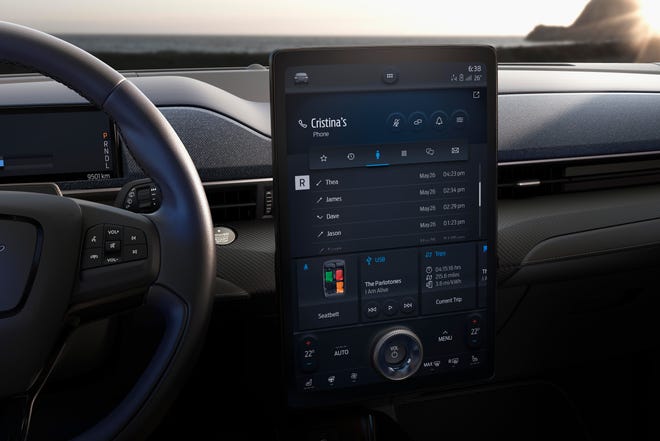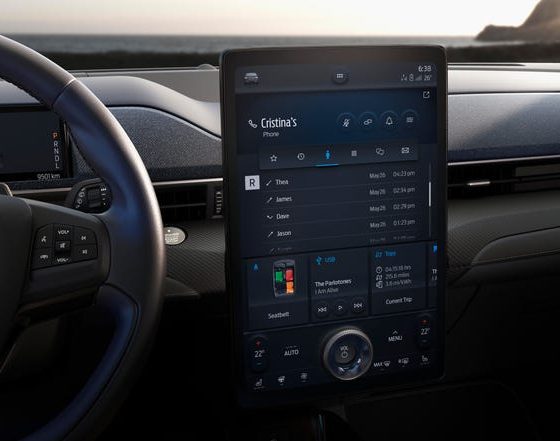Ford has reintroduced what could now be considered the ‘old-school’ way to control climate in your vehicle. The automaker rolled out its most recent software update this week for the Mustang Mach-E, which enables knobs instead of touch-enabled sliders to control the vehicle’s climate control.
Ford’s Power Up 4.1.2 rolled out to Mustang Mach-E owners this week with various features. However, one of the most interesting was Ford’s choice to enable knob-controlled climate control, where drivers will utilize the centrally-located volume knob to control cabin temperature, fan speed, and heated seats.
The volume knob can now be used to control the cabin temperature, fan speed and heated seats. To use these new controls, just tap the temperature, fan or heated-seat screen control once, which will enable control of the feature when turning the volume knob. pic.twitter.com/dg0vOggKw6
— Mike Levine (@mrlevine) January 4, 2023
“Yes, you did read that correctly,” Ford said in 4.1.2 release notes. “The volume knob can now be used to control the cabin temperature, fan speed, and heated seats. To use these new controls, just tap the temperature, fan or heated-seat screen control once, which will enable control of the feature when turning the volume knob. Then take it for a spin and stop when you reach your comfort zone.”
The decision by Ford to move ahead with the reintroduction of a physical knob to control climate is out of the ordinary for the electric vehicles of the past, present, and future. While some electric vehicle owners have now grown used to the minimalistic designs that automakers have adopted, others have not. Although dials, knobs, and buttons may not fit the mold of the futuristic stereotypes many consumers have held for electric cars, they do offer a bit of convenience.
The knob being used for climate control allows drivers to cool or heat their cabin by simply twisting the highly-accessible adjustor. It will no longer require dividing attention between the task of driving and sorting through various prompts and screens to accomplish this task.
Some may see it as backtracking in interior EV design, but it creates a fast and efficient way to change the air temperature in your vehicle. Turning the air up or down a few degrees should not take more than a few seconds to complete, nor should it take the driver’s attention away from navigating the vehicle by any means.
Tesla made minimalistic interiors mainstream in EVs. Not long after the company started influencing other automakers to develop EVs did we see companies mimic Tesla’s touchscreen-dominated design. While the design is certainly personal preference and differs from one driver to the next, Mustang Mach-E owners having the built-in volume dial allowed the automaker the open-ended option of adding this feature after the vehicle was initially released. Vehicles that have completely axed buttons, knobs, and switches altogether will unfortunately not have this luxury.
As vehicles continue to become more advanced, companies will be forced to spar with the idea that their revolutionary new interiors may not fit the model of “classic” features that many drivers still find useful. Luckily for Ford, the volume knob was an idea candidate for easy climate control, and a simple Over-the-Air software update solved the issue without any true difficulty.
I’d love to hear from you! If you have any comments, concerns, or questions, please email me at joey@teslarati.com. You can also reach me on Twitter @KlenderJoey, or if you have news tips, you can email us at tips@teslarati.com.

News
Tesla takes a step towards removal of Robotaxi service’s safety drivers
Tesla watchers are speculating that the implementation of in-camera data sharing could be a step towards the removal of the Robotaxi service’s safety drivers.

Tesla appears to be preparing for the eventual removal of its Robotaxi service’s safety drivers.
This was hinted at in a recent de-compile of the Robotaxi App’s version 25.11.5, which was shared on social media platform X.
In-cabin analytics
As per Tesla software tracker @Tesla_App_iOS, the latest update to the Robotaxi app featured several improvements. These include Live Screen Sharing, as well as a feature that would allow Tesla to access video and audio inside the vehicle.
According to the software tracker, a new prompt has been added to the Robotaxi App that requests user consent for enhanced in-cabin data sharing, which comprise Cabin Camera Analytics and Sound Detection Analytics. Once accepted, Tesla would be able to retrieve video and audio data from the Robotaxi’s cabin.
Video and audio sharing
A screenshot posted by the software tracker on X showed that Cabin Camera Analytics is used to improve the intelligence of features like request support. Tesla has not explained exactly how the feature will be implemented, though this might mean that the in-cabin camera may be used to view and analyze the status of passengers when remote agents are contacted.
Sound Detection Analytics is expected to be used to improve the intelligence of features like siren recognition. This suggests that Robotaxis will always be actively listening for emergency vehicle sirens to improve how the system responds to them. Tesla, however, also maintained that data collected by Robotaxis will be anonymous. In-cabin data will not be linked to users unless they are needed for a safety event or a support request.
Tesla watchers are speculating that the implementation of in-camera data sharing could be a step towards the removal of the Robotaxi service’s safety drivers. With Tesla able to access video and audio feeds from Robotaxis, after all, users can get assistance even if they are alone in the driverless vehicle.
Investor's Corner
Mizuho keeps Tesla (TSLA) “Outperform” rating but lowers price target
As per the Mizuho analyst, upcoming changes to EV incentives in the U.S. and China could affect Tesla’s unit growth more than previously expected.

Mizuho analyst Vijay Rakesh lowered Tesla’s (NASDAQ:TSLA) price target to $475 from $485, citing potential 2026 EV subsidy cuts in the U.S. and China that could pressure deliveries. The firm maintained its Outperform rating for the electric vehicle maker, however.
As per the Mizuho analyst, upcoming changes to EV incentives in the U.S. and China could affect Tesla’s unit growth more than previously expected. The U.S. accounted for roughly 37% of Tesla’s third-quarter 2025 sales, while China represented about 34%, making both markets highly sensitive to policy shifts. Potential 50% cuts to Chinese subsidies and reduced U.S. incentives affected the firm’s outlook.
With those pressures factored in, the firm now expects Tesla to deliver 1.75 million vehicles in 2026 and 2 million in 2027, slightly below consensus estimates of 1.82 million and 2.15 million, respectively. The analyst was cautiously optimistic, as near-term pressure from subsidies is there, but the company’s long-term tech roadmap remains very compelling.
Despite the revised target, Mizuho remained optimistic on Tesla’s long-term technology roadmap. The firm highlighted three major growth drivers into 2027: the broader adoption of Full Self-Driving V14, the expansion of Tesla’s Robotaxi service, and the commercialization of Optimus, the company’s humanoid robot.
“We are lowering TSLA Ests/PT to $475 with Potential BEV headwinds in 2026E. We believe into 2026E, US (~37% of TSLA 3Q25 sales) EV subsidy cuts and China (34% of TSLA 3Q25 sales) potential 50% EV subsidy cuts could be a headwind to EV deliveries.
“We are now estimating TSLA deliveries for 2026/27E at 1.75M/2.00M (slightly below cons. 1.82M/2.15M). We see some LT drivers with FSD v14 adoption for autonomous, robotaxi launches, and humanoid robots into 2027 driving strength,” the analyst noted.
News
Tesla’s Elon Musk posts updated Robotaxi fleet ramp for Austin, TX
Musk posted his update on social media platform X.

Elon Musk says Tesla will “roughly double” its supervised Robotaxi fleet in Austin next month as riders report long wait times and limited availability across the pilot program in the Texas city. Musk posted his update on social media platform X.
The move comes as Waymo accelerates its U.S. expansion with its fully driverless freeway service, intensifying competition in autonomous mobility.
Tesla to increase Austin Robotaxi fleet size
Tesla’s Robotaxi service in Austin continues to operate under supervised conditions, requiring a safety monitor in the front seat even as the company seeks regulatory approval to begin testing without human oversight. The current fleet is estimated at about 30 vehicles, StockTwists noted, and Musk’s commitment to doubling that figure follows widespread rider complaints about limited access and “High Service Demand” notifications.
Influencers and early users of the Robotaxi service have observed repeated failures to secure a ride during peak times, highlighting a supply bottleneck in one of Tesla’s most visible autonomy pilots. The expansion aims to provide more consistent availability as the company scales and gathers more real-world driving data, an advantage analysts often cite as a differentiator versus rivals.
Broader rollout plans
Tesla’s Robotaxi service has so far only been rolled out to Austin and the Bay Area, though reports have indicated that the electric vehicle maker is putting in a lot of effort to expand the service to other cities across the United States. Waymo, the Robotaxi service’s biggest competitor, has ramped its service to areas like the San Francisco Bay Area, Los Angeles, and Phoenix.
Analysts continue to highlight Tesla’s long-term autonomy potential due to its global fleet size, vertically integrated design, and immense real-world data. ARK Invest has maintained that Tesla Robotaxis could represent up to 90% of the company’s enterprise value by 2029. BTIG analysts, on the other hand, added that upcoming Full Self-Driving upgrades will enhance reasoning, particularly parking decisions, while Tesla pushes toward expansions in Austin, the Bay Area, and potentially 8 to 10 metro regions by the end of 2025.









